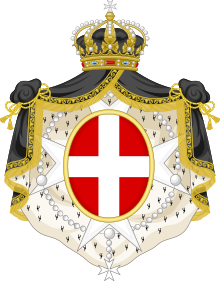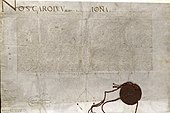Knights Hospitaller
Earlier in the 11th century, merchants from Amalfi founded a hospital in Jerusalem dedicated to John the Baptist where Benedictine monks cared for sick, poor, or injured Christian pilgrims to the Holy Land.The organization became a military religious order under its own papal charter, charged with the care and defence of the Holy Land, and fought in the Crusades until the Siege of Acre in 1291.Following the reconquest of the Holy Land by Islamic forces, the knights operated from Rhodes, over which they were sovereign, and later from Malta, where they administered a vassal state under the Spanish viceroy of Sicily.Merchants from Amalfi in southern Italy were given permission by the Egyptian Fatimid Caliph al-Mustansir Billah (r. 1036–1094) to build a monastery in Jerusalem, near the Church of the Holy Sepulchre.The monastic Hospitaller Order was formally created when the Pope issued the papal bull Pie postulatio voluntatis on 15 February 1113 to the head of the Hospital of St John, Blessed Gerard de Martigues.A charter made for a gift to the Hospital of St John in a Christian army on 17 January 1126 recorded that a brother from the Order was present as a witness and that he held a military title.[14] The other symbol of the Hospitallers, the "eight-pointed cross", is said to have originated in the Byzantine Empire before reaching the Duchy of Amalfi in Italy, and it was later used in Jerusalem by the monks that founded the Hospital of St John.After a group of Knights Templar, led by their Grand Master, Bernard de Tremelay, entered the besieged fortress and were all killed, King Baldwin III of Jerusalem wanted to withdraw, but Raymond du Puy convinced him to continue, and the fort surrendered to the Crusaders on 22 August 1153.The Knights also received the "Land of Severin" (Terra de Zeurino), along with the nearby mountains, from Béla IV of Hungary, as shown by a charter of grant issued on 2 June 1247.Finding themselves becoming enmeshed in Cypriot politics, their Master, Guillaume de Villaret, created a plan of acquiring their own temporal domain, selecting Rhodes, then part of the Byzantine Empire.In 1334, they fought an attempted invasion by Andronicus and his Turkish auxiliaries,[29] and in 1374 they took over the defence of nearby Smyrna on the Anatolian coast, which had been conquered by a crusade in 1344;[30] the knights held the city until it was besieged and taken by Timur in 1402.Despite the defeat, both Christians and Muslims seem to have regarded Phillipe Villiers as extremely valiant, and the Grand Master was proclaimed a Defender of the Faith by Pope Adrian VI.In 1530, after seven years of displacement from Rhodes, Pope Clement VII – himself a knight – reached an agreement with Charles V, Holy Roman Emperor and King of Spain and Sicily, to provide the knights permanent quarters: In exchange for providing Malta,[34][35] Gozo, and the North African port of Tripoli in perpetual fiefdom, Charles V would receive an annual fee of a single Maltese falcon (the Tribute of the Maltese Falcon), which they were to send on All Souls' Day to the king's representative, the Viceroy of Sicily.The knights would stay in Malta for the next 268 years, transforming what they called "merely a rock of soft sandstone" into a flourishing island with mighty defences, whose capital city, Valletta, would become known as Superbissima, "Most Proud", among the great powers of Europe.The knights were forced to make do with their maritime location and turn to combating the increased threat of piracy, particularly from the Ottoman-endorsed Barbary pirates operating out of North Africa.[46]: 109 More and more ships were plundered, from whose profits many knights lived idly and luxuriously, taking local women to be their wives and enrolling in the navies of France and Spain in search of adventure, experience, and yet more money.[50]: 432 This decision went against the knights' cardinal reason for existence, in that by serving a European power directly they faced the very real possibility that they would be fighting against another Roman Catholic force, as in the few Franco-Spanish naval skirmishes that occurred in this period.[50]: 434 The biggest paradox is the fact that for many years the Kingdom of France remained on amicable terms with the Ottoman Empire, the Knights' greatest and bitterest foe and purported sole purpose for existence."[51]With the knights' exploits growing in fame and wealth, the European states became more complacent about the Order, and more unwilling to grant money to an institution that was perceived to be earning a healthy sum on the high seas.Thus, a vicious cycle occurred, increasing the raids and reducing the grants received from the nation-states of Christendom to such an extent that the balance of payments on the island had become dependent on conquest.In February 1641 a letter was sent from an unknown dignitary in the Maltese capital of Valletta to the knights' most trustworthy ally and benefactor, Louis XIV of France, stating the Order's troubles: Italy provides us with nothing much; Bohemia and Germany hardly anything, and England and the Netherlands for a long time now nothing at all.[46]: 109 In an effort to regulate the growing problem, the authorities in Malta established a judicial court, the Consiglio del Mer, where captains who felt wronged could plead their case, often successfully.The practice of issuing privateering licenses and thus state endorsement, which had been in existence for a number of years, was tightly regulated as the island's government attempted to haul in the unscrupulous knights and appease the European powers and limited benefactors.Ultimately, the rampant over-indulgence in privateering in the Mediterranean was to be the knights' downfall in this particular period of their existence as they transformed from serving as the military outpost of a united Christendom to becoming another nation-state in a commercially oriented continent soon to be overtaken by the trading nations of the North Sea.[43] Napoleon demanded from Grand Master Ferdinand von Hompesch zu Bolheim that his ships be allowed to enter the port and to take on water and supplies.Its 13,500 members and 95,000 volunteers and over 52,000 medical personnel – doctors, nurses and paramedics – are dedicated to the care of the poor, the sick, the elderly, the disabled, the homeless, terminal patients, lepers, and all those who suffer.The Order is especially involved in helping victims of armed conflicts and natural disasters by providing medical assistance, caring for refugees, and distributing medicines and basic equipment for survival.The Holy See later retracted its decision stating a number of conflicts with Tsar Paul I, since he did not follow the precepts binding the Grand Master: he was married and not celibate; he had never been to Malta and declined to live there; and he was not a Roman Catholic.[76] The large passage fees collected by the American Association of SMOM in the early 1950s may well have tempted Charles Pichel to create his own "Sovereign Order of St John of Jerusalem, Knights Hospitaller" in 1956.[25] Another self-styled Order, based in the US, gained a substantial following under the leadership of the late Robert Formhals, who for some years, and with the support of historical organisations such as The Augustan Society, claimed to be a Polish prince of the House of Sanguszko.















Order of Saint John (disambiguation)Hospitaller (disambiguation)Coat of armseight-pointed crossCrusadesCatholicmilitary orderHeadquartersJerusalemRhodesVallettaOur Lady of PhilermosJohn the BaptistSiege of Damascus (1148)Siege of AscalonCrusader invasions of EgyptBattle of CressonBattle of HattinSiege of Jerusalem (1187)Siege of Belvoir CastleSiege of Sahyun CastleSiege of Safed (1188)Siege of Acre (1189–1191)Battle of ArsufBattle of Las Navas de TolosaSiege of Alcácer do SalSiege of Mount TaborBattle of Fariskur (1219)Battle of Mansurah (1221)Conquest of MajorcaSiege of BurrianaSiege of Ascalon (1247)Fall of ArsufFall of Haifa (1265)Siege of Safed (1266)Fall of Krak des ChevaliersSecond Battle of HomsSiege of MargatFall of Tripoli (1289)Siege of Acre (1291)Hospitaller conquest of RhodesBattle of Amorgos (1312)Battle of Chios (1319)Battle of Rhodes (1320)Battle of Adramyttion (1334)Battle of PalleneBattle of Imbros (1347)Battle of Megara (1359)Battle of KosovoBattle of NicopolisSiege of SmyrnaSiege of Rhodes (1444)Ottoman conquest of LesbosOttoman–Venetian War (1463–1479)Siege of Rhodes (1480)Siege of Rhodes (1522)Battle of PrevezaAlgiers expedition (1541)Capture of Mahdia (1550)Invasion of Gozo (1551)Siege of Tripoli (1551)Battle of DjerbaBattle of VerbiaGreat Siege of MaltaAction of 1570Battle of LepantoBattle of Pantelleria (1586)Action of 1595Battle of HammametRaid on ŻejtunBattle of Chios (1621)Battle of Palermo (1624)Battle of the Gulf of TunisBattle of the Dalmatian CoastAction of 26 June 1625Action of 28 September 1644Battle of the Dardanelles (1656)Battle of the Dardanelles (1657)Action of 27 August 1661Djidjelli expeditionSiege of CandiaBattle of MatapanBombardment of Algiers (1784)French invasion of MaltaGrand MasterGérard de MartiguesJohn T. DunlapJean Parisot de ValettePhilippe Villiers de L'Isle-AdamGarnier de NabluscrusaderKingdom of JerusalemKolossi CastleSaint PetersburgCluniac movementBenedictine monastic orderAmalfihospitalpilgrimsHoly LandBlessed Gerardconquest of Jerusalem in 1099First CrusaderecognizedPope Paschal IISiege of Acresovereignvassal stateSpanishSicilyCaribbeanFranceProtestant Reformationcommanderies of the orderremaining separate to this dayecumenicalNapoleoncapture of MaltaSovereign Military Order of MaltaMost Venerable Order of the Hospital of Saint JohnBailiwick of Brandenburg of the Chivalric Order of Saint JohnOrder of Saint John in the NetherlandsOrder of Saint John in SwedenHistory of the Knights Hospitaller in the LevantPie postulatio voluntatisPope Gregory I

